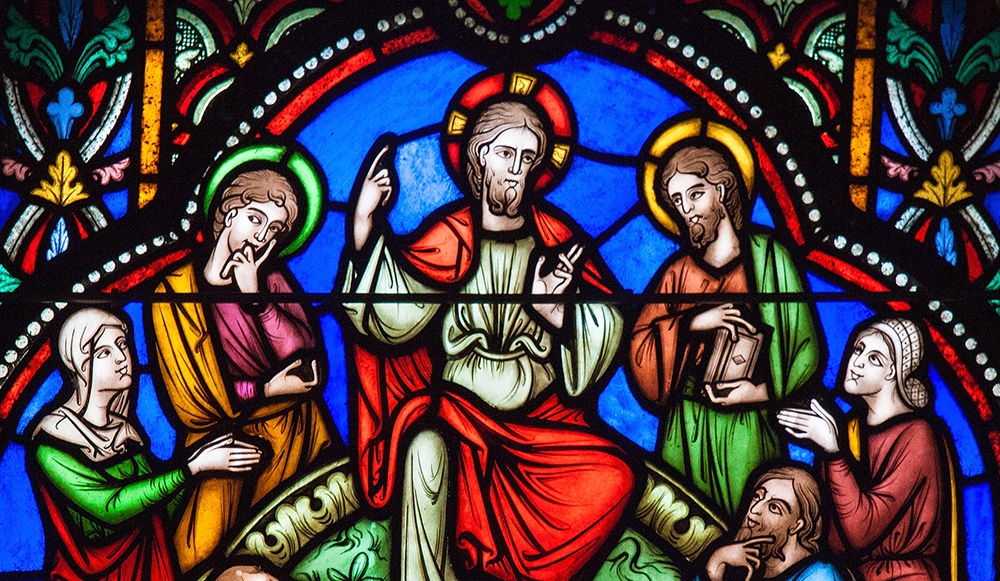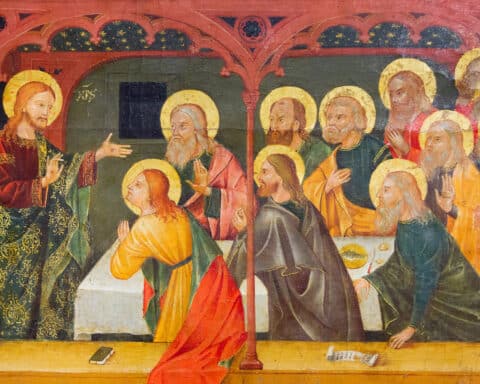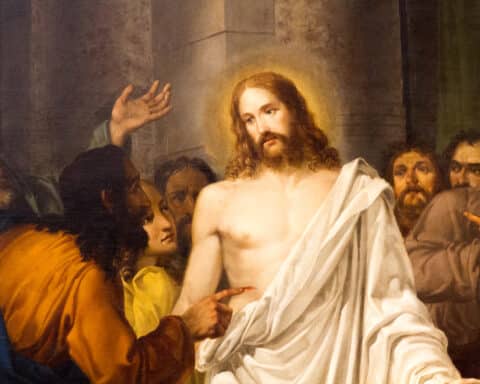This is the fourth in a 12-part series of In Focuses dedicated to exploring some central themes and texts in the Gospel of Matthew.
In the prologue to his Gospel, St. John teaches “because while the law was given through Moses, grace and truth came through Jesus Christ” (Jn 1:17). By itself, the contrast might sound dismissive, as though it were saying “Moses gave us a poor thing, but Jesus gave something wonderful!” This sort of understanding has not infrequently characterized Christians’ assessment of the Old Testament and of Judaism. But this is not what John means in the least. In the prior verse he tells us that “from [Jesus’] fullness, we have all received grace in place of grace.” Or better, “grace upon grace” (Jn 1:16). As Jesus himself says to the woman at the well, “salvation is from the Jews” (Jn 4:22), and as John is at pains to show throughout, Jesus is the fulfillment of what is celebrated in the Jewish festivals. Jesus, for instance, is the new Passover lamb who delivers us not from the slavery of Egypt but from the slavery of sin and death. “Behold, the Lamb of God, who takes away the sins of the world” (Jn 1:29). The contrast between Moses and Jesus is not adversative but complementary. Praise God for what was given through Moses; praise him all the more in Jesus Christ.
| 5 QUESTIONS TO CONSIDER |
|---|
|
Fulfilling the Law
St. Matthew presents this comparison as well. We have already seen the way in which Jesus’ infancy and his temptation in the desert parallel those of Moses and the generation of the Exodus. In addition to his identity as “Son of David, son of Abraham” (Mt 1:1), Jesus is portrayed by Matthew as a prophet like Moses, and so the Sermon on the Mount is something like a new revelation at Sinai — except that it isn’t. Not exactly. Much as in the Gospel of John, Jesus offers “grace upon grace,” not the negation of the Law but its uplifting and perfection. What comes forth from the mouth of Jesus in the sermon cannot be heard as an abrogation of the Law of Moses. Yes, “For freedom Christ set us free” (Gal 5:1), but that freedom consists in the keeping of the Law as it is transfigured in Christ. “Do not think I have come to abolish the law or the prophets. I have come not to abolish but to fulfill. … I tell you, unless your righteousness surpasses that of the scribes and Pharisees, you will not enter the kingdom of heaven” (Mt 5:17, 20).
It will help us understand this complex relationship if we step back for a moment. In the first creation account, the human couple is said to be made in God’s “image” and “likeness” (Gn 1:26). These terms in Hebrew mean to identify man as the delegate or envoy or vicar of God. What the Lord begins in the act of creation he hands on to the human couple. The commands to “be fertile and multiply” (Gn 1:28) and to “have dominion” (Gn 1:26, 28) echo God’s own activity in Genesis 1 of drawing things into existence and ordering them well. Seen in this way, the vocation of humanity from its very creation consists of an imitatio dei, an imitation of God.
After the disfiguration of the Fall, this task is given definite shape in the gift of the Law to Israel. In Leviticus, it says that those who follow God’s statues “will find life through them” (Lev 18:5), and these are the means by which Israel might (in principle at least) fulfill the command “Be holy, for I, the Lord your God, am holy” (Lev 19:2). Said otherwise, the Law stipulates for fallen humanity what it is to begin again to live in the image and likeness of God, what it is to live an authentically human life. It does so by revealing — in precepts often adjusted to a particular context, to a particular time, to a particular people — the very shape of God’s own life. As such it is, curiously, both absolute and provisional. It is absolute, too, in that it reveals something of the Lord, who does not change (cf. Mal 3:6); it is provisional in that this revelation, given in the form of specific commands, is accommodated to the particular needs of Israel. Even with the Pentateuch itself, between the law in Exodus and the law in Deuteronomy, we see the same topics addressed in different ways.
St. Thomas Aquinas captures this play between the Law as absolute and as provisional with his distinction between the “Eternal Law” — which is God himself — and the “Divine Law” revealed to Moses (cf. Summa I-II.91). The latter approximates God, but it is not synonymous with the Eternal Law himself. It approaches the reality of the divine life but it is more dissimilar than not. It is good, but it stands in need of fulfillment. It is grace, but it awaits “grace upon grace.”
In Jesus, the Eternal Law “became flesh and made his dwelling among us” (Jn 1:14). The same is shown by Matthew when he relates the words spoken to Joseph in a dream: “[I]t is through the Holy Spirit that this child has been conceived in her” (Mt 1: 20). All that the Law approximates is now, in Jesus, made manifest in Israel. And so, the life of Jesus is not to be measured by its correspondence to all that the Law commands. That would set everything backward! It is rather that the Law is to be measured by its correspondence to Jesus the Lord. He cannot be anything but be the fulfillment of the Law for the Law is nothing but an imitation of God. Jesus — God in the flesh — is the living reality of which the Law speaks.
So it is that in the Beatitudes that Jesus commends fidelity to himself as the true path to righteousness. Recall that after Jesus proclaims as blessed those who “are persecuted for the sake of righteousness” (Mt 5:10), he says to the crowd directly “blessed are you when they insult you and persecute you and utter every kind of evil against you [falsely] because of me” (Mt 5:11). To exceed the scribes and Pharisees is to keep the Law in and with the person of Jesus. It is, in the words of St, Paul, to be able to say “yet I live, no longer I, but Christ lives in me” (Gal 2:20).

Take up the cross
We see then how the Sermon on the Mount is precisely not something like a new revelation at Sinai. The Church does not receive these words as a new code of law. Rather, it recognizes in these words an adumbration of the life of Jesus. What he announces is himself. What he commands in the sermon he enacts in the flesh. In their “International Critical Commentary” on Matthew, W. D. Davies and D. C. Allison demonstrate this well: “If Jesus speaks of eschewing violence and not restraining evil, of being slapped, of having one’s clothes taken, and of being compelled to serve the Romans, the conclusion to his own life makes his words concrete: he eschews violence (26:51-4); he does not resist evil (26:46-56; 27:12-14); he is struck (26:67); he has his garments taken (27:28, 35); and his cross is carried by one requisitioned by Roman order (27:32).”
This equivalence between the teaching in the Sermon on the Mount and the life of Jesus affects how these chapters are to be received by you and me. Without this identification, we might regard the sermon as the presentation of an unattainable ideal — “So be perfect, just as your heavenly Father is perfect” (Mt 5:48). The severity of its demands could be written off as rhetorical. This is not possible, though. The sermon is not the sketching of an unattainable moral ideal. It is the description of what Christ achieves in the flesh and so precisely what he asks of you and me. If in its expression, the sermon does indeed speak rhetorically — as when Jesus invites us to pluck out our eyes and cut off our hands (cf. Mt 5:29-30) — the substance of these demands nevertheless remains. One cannot bypass the command to live as Christ lived.
Then Jesus said to his disciples, “Whoever wishes to come after me must deny himself, take up his cross, and follow me. For whoever wishes to save his life will lose it, but whoever loses his life for my sake will find it. What profit would there be for one to gain the whole world and forfeit his life? Or what can one give in exchange for his life? For the Son of Man will come with his angels in his Father’s glory, and then he will repay everyone according to his conduct” (Mt 16:24-27).

A heart of love
The heart of the sermon comes with the command to love one’s enemies. In this passage, Jesus begins with reference to the Old Law, “‘You have heard that it was said, ‘You shall love your neighbor and hate your enemy'” (Mt 5:43). The latter half of this is not attested in any one commandment, but the sentiment is found in various places. We might think, for example, of the psalmist who asks: “Do I not hate, Lord, those that hate you? Those who rise against you, do I not loathe?” (Ps 139:21). The first half of the quotation mentions the command in Leviticus: “Take no revenge and cherish no grudge against your own people. You shall love your neighbor as yourself” (19:18).
Jesus quotes this verse again in his teaching on the greatest commandment (cf. Mt 22:34-40). While Leviticus understands “neighbor” to refer only to “your own people,” Israel, Jesus expands this to include all (cf. Mt 25:31-46). In the sermon, Jesus goes further. Those of whom he commands us to love sit well beyond the boundaries of our “own people” and encompass those who rise against us. “But I say to you, love your enemies and pray for those who persecute you” (Mt 5:44).
The rationale for this teaching is not pragmatic. Jesus does not promise that by doing so his followers will turn the evil person from her ways. Rather, if the Christian would be “perfect, just as your heavenly Father is perfect,” she must, as it were, make the sun rise on the bad and the good and the rain to fall on the just and the unjust. She must act in the likeness of God himself. Specifically, she must love as Jesus has loved. As Jesus says in the Gospel of Luke, “Father, forgive them, they know not what they do” (Lk 23:34). Or again, as Jesus says in the Gospel of John, “I give you a new commandment: love one another. As I have loved you, so you also should love one another” (Jn 13:34).
| 3 KEY LESSONS |
|---|
|
This command to embody God’s gratuitousness is echoed at two other places in the sermon. In the Lord’s Prayer, the forgiveness of sin is not contingent on some act of reparation. Rather, it comes by way of enacting the same gratuitous love we hope to receive: “and forgive us our debts, as we forgive our debtors” (Mt 6:12).
It appears lastly in the so-called Golden Rule. This teaching comes just before the warnings that conclude the sermon. In teaching us to “Do unto others what you would have them do unto you,” Jesus again makes no appeal to the effect that such action will bring about or to the merit of our neighbors. We are simply to extend to them the same generosity we ourselves hope to receive. We are, again, to make it rain on the just and unjust. In this, we act in imitation of Jesus who is himself the fullness of which the Law speaks. “Do unto others whatever you would have them do unto you. This is the law and the prophets” (Mt 7:12).
Anthony Pagliarini is an assistant teaching professor and director of undergraduate studies in the Department of Theology at the University of Notre Dame.
| Coming Next Month |
|---|
|
In April, we will discuss how Matthew gathers the accounts of Jesus’ miracles into two short chapters (8-9) and arranges them so as to better present the identity of Jesus as messiah and Lord. We will explore each of these stories and make the disciples’ question our own: “What sort of man is this, whom even the winds and the sea obey?” (Mt 8:27).
|





